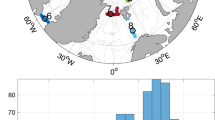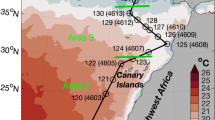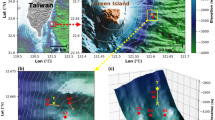Abstract
The backscattering of high-frequency radar echoes from the sea surface can yield useful information about ocean waves and surface currents1–3. The Rutherford Appelton Laboratory Ocean Surface Current Radar (OSCR) system is based on the CODAR system4 but differs significantly in that it uses a beam-forming receive antenna to determine the direction of the backscattered signals instead of using the CODAR direction finding system. OSCR derives a radial component of surface velocity by measuring the shift in recorded spectra associated with advancing and receding waves. In this survey of surface currents in Liverpool Bay, using only OSCR, measurements were made first for 7 days from the Lancashire coast followed, 1 month later, by similar measurements from the Wirral coast. These were combined to compute current ellipses for the predominant M2 tidal constituent. Spatial distributions of the ellipse parameters agree well with values obtained from a numerical model and from moored current meters. This new observational technique should provide data on the fine structure of near-shore surface currents for use in studies of sediment transport and pollutant dispersal.
This is a preview of subscription content, access via your institution
Access options
Subscribe to this journal
Receive 51 print issues and online access
$199.00 per year
only $3.90 per issue
Buy this article
- Purchase on Springer Link
- Instant access to full article PDF
Prices may be subject to local taxes which are calculated during checkout
Similar content being viewed by others
References
Barrick, D. E. Boundary-Layer Met. 13, 23–43 (1978).
Shearman, E. D. R. Proc. Instn. elect. Engr. 130, 579–590 (1983).
Leise, J. A. IEEE J. Ocean Engng OE- 9, 106–113 (1984).
Barrick, D. E., Evans, M. W. & Webber, B. L. Science 198, 138–144 (1977).
King, J. W. et al. Current Measurements Offshore (Society for Underwater Technology, London, 1984).
Prandle, D. Continent. Shelf Res. 1, 191–207 (1982).
Prandle, D. Geophys. Astrophys. Fluid Dyn. 22, 29–49 (1982).
Out of Sight Out of Mind Vol. 1–4 (HMSO, London, 1972–76).
Frisch, A. S. & Weber, B. L. J. geophys. Res. 85, 485–493 (1980).
Holbrook, J. R. & Frisch, A. S. J. geophys. Res. 86, 10908–10912 (1981).
Maresca, J. W. Jr, Padden, P. R., Chang, R. T. & Seibel, E. Limnol. Oceanogr. 25, 929–935 (1980).
Author information
Authors and Affiliations
Rights and permissions
About this article
Cite this article
Prandle, D., Ryder, D. Measurement of surface currents in Liverpool Bay by high-frequency radar. Nature 315, 128–131 (1985). https://doi.org/10.1038/315128a0
Received:
Accepted:
Issue Date:
DOI: https://doi.org/10.1038/315128a0
This article is cited by
-
Drifter trajectory tracking experiment and analysis with multi-frequency HFSWR in the East China Sea
Wuhan University Journal of Natural Sciences (2011)
Comments
By submitting a comment you agree to abide by our Terms and Community Guidelines. If you find something abusive or that does not comply with our terms or guidelines please flag it as inappropriate.



